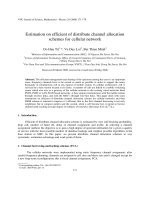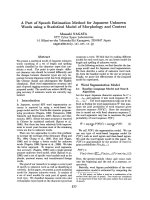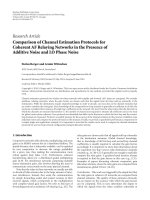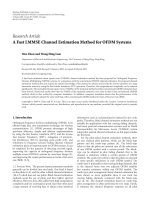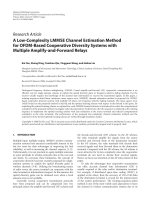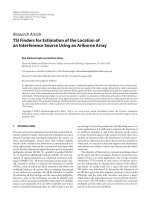Improved channel estimation schemes for DS CDMA RAKE receiver with the use of multiuser interference canceller
Bạn đang xem bản rút gọn của tài liệu. Xem và tải ngay bản đầy đủ của tài liệu tại đây (687.74 KB, 106 trang )
IMPROVED CHANNEL ESTIMATION SCHEMES FOR
DS-CDMA RAKE RECEIVER WITH THE USE OF
MULTIUSER INTERFERENCE CANCELLER
TIE LOK TIING
NATIONAL UNIVERSITY OF SINGAPORE
2004
IMPROVED CHANNEL ESTIMATION SCHEMES FOR
DS-CDMA RAKE RECEIVER WITH THE USE OF
MULTIUSER INTERFERENCE CANCELLER
TIE LOK TIING
(B. Eng. (Hons.), National University of Singapore)
A THESIS SUBMITTED
FOR THE DEGREE OF MASTER OF ENGINEERING
DEPARTMENT OF ELECTRICAL AND COMPUTER ENGINEERING
NATIONAL UNIVERSITY OF SINGAPORE
2004
i
Acknowledgement
I would like to take this opportunity to thank my first supervisor, Dr. Chew
Yong Huat, from Institute for Infocomm Research, for his constant support, encouragement and guidance, throughout my research years. I also thank my second supervisor, Dr. Nallanathan Arumugam, from Department of Electrical and
Computer Engineering, National University of Singapore, for being a constant
source of ideas and guidance, and for helping me believe in my work.
I also wish to stretch my gratitude to my colleagues from Institute for Infocomm Research, especially Hu Xiao Yu, Lim Wei Chee, Yang Yang, Long Hai
and Ng Woon Wei, for helping me to organize my thoughts and their valuable
times spent on discussion.
I should also mention that my scholarship of my graduate study in National
University of Singapore was supported by Institute for Infocomm Research.
ii
Contents
Acknowledgement
i
Contents
ii
Summary
v
List of Figures
vii
Abbreviations
x
List of Symbols
Chapter 1. Introduction
xi
1
1.1
Problem Description . . . . . . . . . . . . . . . . . . . . . . . . .
2
1.2
Research Motivations and Contributions . . . . . . . . . . . . . .
6
1.3
Thesis Outline . . . . . . . . . . . . . . . . . . . . . . . . . . . . .
7
Chapter 2. Mobile Radio Channels
2.1
2.2
2.3
Propagation Channel . . . . . . . . . . . . . . . . . . . . . . . . .
9
9
2.1.1
Flat and Frequency-selective Fading . . . . . . . . . . . . .
15
2.1.2
Fast and Slow Fading . . . . . . . . . . . . . . . . . . . . .
16
Rayleigh Fading Generator . . . . . . . . . . . . . . . . . . . . . .
16
2.2.1
Mathematical Reference Model . . . . . . . . . . . . . . .
17
2.2.2
Clarke’s Model . . . . . . . . . . . . . . . . . . . . . . . .
17
2.2.3
Jakes’ Model Generator . . . . . . . . . . . . . . . . . . .
18
DS-CDMA System and Channel Model . . . . . . . . . . . . . . .
20
Contents
iii
2.3.1
Continuous time received signal . . . . . . . . . . . . . . .
21
2.3.2
Discrete time received signal . . . . . . . . . . . . . . . . .
22
Chapter 3. CDMA Systems Background
3.1
27
Cellular CDMA Systems . . . . . . . . . . . . . . . . . . . . . . .
27
3.1.1
Short Sequence Systems . . . . . . . . . . . . . . . . . . .
28
3.1.2
Uplink Transceiver Structures . . . . . . . . . . . . . . . .
29
3.2
RAKE receiver . . . . . . . . . . . . . . . . . . . . . . . . . . . .
32
3.3
Parallel Interference Cancellation . . . . . . . . . . . . . . . . . .
35
3.4
Implementation of Parameter Estimates in RAKE Receiver . . . .
37
3.4.1
Conventional single-user detection . . . . . . . . . . . . . .
37
3.4.2
Multiuser and multipath interference cancellation . . . . .
43
Chapter 4. Training-based Decoupled Maximum Likelihood Channel Estimation
46
4.1
The DEML Channel Estimation Method . . . . . . . . . . . . . .
47
4.2
Recursive Method and Computational Complexity . . . . . . . . .
52
4.3
Influence of Pilot Symbol Length . . . . . . . . . . . . . . . . . .
54
4.3.1
Analytical Results on Pilot Length . . . . . . . . . . . . .
56
4.3.2
Simulation Results on Pilot Length . . . . . . . . . . . . .
60
Simulation Results for Estimator . . . . . . . . . . . . . . . . . .
64
4.4.1
Simulation Parameters . . . . . . . . . . . . . . . . . . . .
64
4.4.2
Probability of Correct Acquisition against M . . . . . . . .
64
4.4.3
BER Performance against SNR . . . . . . . . . . . . . . .
66
4.4.4
BER Performance against Number of Users, K
. . . . . .
68
4.4.5
Tracking Performance . . . . . . . . . . . . . . . . . . . .
68
4.4.6
BER Performance with Different Number of Paths . . . . .
70
4.4
Chapter 5. PIC-based DEML Channel Estimation
5.1
PIC-based Channel Estimation Model . . . . . . . . . . . . . . . .
72
75
Contents
iv
5.2
Statistical Accuracy of the Estimator . . . . . . . . . . . . . . . .
76
5.3
Simulation Results . . . . . . . . . . . . . . . . . . . . . . . . . .
79
5.3.1
MSE against SNR . . . . . . . . . . . . . . . . . . . . . . .
79
5.3.2
BER Performance against SNR . . . . . . . . . . . . . . .
81
5.3.3
BER Performance against Number of Users, K
. . . . . .
81
5.3.4
BER Performance with Different Number of Paths . . . . .
85
Chapter 6. Conclusions
86
List of Publications
88
Bibliography
89
v
Summary
Direct-sequence code division multiple access (DS-CDMA) is a promising
technology for future mobile communications. However for high bit rate transmission, several transmission problems including channel fading due to multipath
propagation, Doppler effect and multiuser interference exist. The presence of
these impairments give rise to the need for estimating the channel gain coefficients and its accuracy thus restricting the performance of RAKE receiver, which
is usually used as the basic building block for more complex receiver structures
to overcome inter-symbol interference (ISI). Furthermore, precise knowledge of
propagation delays is required for accurate code despreading in RAKE receiver.
These parameters need to be estimated in practice and will, therefore, be subject
to estimation errors. The speed of estimation process is another concern which
leads to the design of low complexity and high efficient algorithm in this thesis.
The two corresponding tasks, delay and channel gain coefficients estimation
for RAKE receiver, are the focus of this thesis. A decoupled maximum likelihood (DEML) channel estimation scheme using recursive matrix computation is
proposed for asynchronous DS-CDMA communication systems. The DEML esti-
Summary
vi
mation is obtained using training sequence. In the DEML algorithm, a recursive
method is used to find the estimator so as to spread the computational time over
each processing window. Next, the proposed recursive technique is extended to
track moderate time-varying fading channel using decision feedback.
Also, the RAKE receiver structure that employs parallel interference cancellation (PIC) both for detection and channel parameters estimation for Rayleigh
frequency selective fading environments is proposed. The estimator unit starts
with a training mode then reverts to a decision-directed mode. In the training
mode, the initial values of multipath delays and channel gain coefficients of all
users are estimated. These initial parameters are used for parallel multiuser interference cancellation. Once the interference is cancelled, the signal is fed to the
estimator for fine estimation of delays and channel gain coefficients of all users.
These more accurate estimates are used for detecting the next symbol interval.
This process continues in the decision-directed mode. Simulations of BER performance using the proposed receiver architecture and algorithm in the uplink
shows noticeable performance improvement compared to that of channel estimation using conventional PIC receiver structure under multipath fading condition.
This is proved theoretically.
Lastly, the thesis is concluded with summary of works and contributions.
vii
List of Figures
1.1
A wireless transmission system . . . . . . . . . . . . . . . . . . . .
3
1.2
Asynchronous nature of uplink transmission together with multipaths
4
2.1
Rayleigh fading magnitude profile for fd T = 0.001 . . . . . . . . .
11
2.2
Rayleigh fading phase profile for fd T = 0.001 . . . . . . . . . . . .
12
2.3
Doppler shift caused by a moving vehicle . . . . . . . . . . . . . .
14
2.4
Frequency domain implementation of Clarke’s model simulator at
baseband. . . . . . . . . . . . . . . . . . . . . . . . . . . . . . . .
2.5
19
Contributions of the spreading sequence and transmitted bits of
respective users and path to the received signal, assuming constant
channel parameters of 1 and no noise situation. . . . . . . . . . .
2.6
23
The fundamental structure of the matrix S for multipath CDMA
with K = 3, L = 2, N = 8, M = 2. The delays for the three users
are (0,5Tc ), (3,4Tc ) and (2,7Tc ) respectively. . . . . . . . . . . . .
25
3.1
Mobile user transmitter . . . . . . . . . . . . . . . . . . . . . . . .
31
3.2
Base station receiver . . . . . . . . . . . . . . . . . . . . . . . . .
31
3.3
MRC-RAKE receiver structure for user k . . . . . . . . . . . . . .
34
3.4
Coherent detector for user k at finger m (CohDetk,m ) . . . . . . .
34
3.5
Fundamental PIC receiver structure . . . . . . . . . . . . . . . . .
36
3.6
MRC RAKE receiver . . . . . . . . . . . . . . . . . . . . . . . . .
38
List of Figures
3.7
viii
RAKE with single stage PIC receiver structure for accurate decision feedback channel estimation
. . . . . . . . . . . . . . . . . .
45
3.8
Path regenerative block for user k at path m (PRegk,m ) . . . . . .
45
4.1
Channel errors due to noise Jn and hysteresis Jd as a function of
pilot symbol length, L . . . . . . . . . . . . . . . . . . . . . . . .
4.2
Theoretical and numerical results of channel M SE against L for
SN R = 0dB under various fade rates . . . . . . . . . . . . . . . .
4.3
69
Phase of channel tracking performance for K = 5, SN R = 10dB, N =
31, M = 2, fd T = 0.0001 . . . . . . . . . . . . . . . . . . . . . . .
4.9
68
Absolute value of channel tracking performance for K = 5, SN R =
10dB, N = 31, M = 2, fd T = 0.0001 . . . . . . . . . . . . . . . . .
4.8
67
BER performance against K for SN R = 10dB, N = 31, M =
2, fd T = 0.0001 . . . . . . . . . . . . . . . . . . . . . . . . . . . .
4.7
65
BER performance against SN R for K = 5, N = 31, M = 2, fd T =
0.0001 . . . . . . . . . . . . . . . . . . . . . . . . . . . . . . . . .
4.6
62
Probability of correct delay acquisition for DEML estimator against
L for K = 5, SN R = 10dB, N = 31, M = 2, fd T = 0.0001 . . . . .
4.5
61
Theoretical and numerical results of channel M SE against L for
fd T = 0.001 under various SN R conditions . . . . . . . . . . . . .
4.4
55
69
BER performance against SN R for K = 5, N = 31, M = 2, fd T =
0.0001 . . . . . . . . . . . . . . . . . . . . . . . . . . . . . . . . .
70
5.1
Proposed channel estimation receiver structure
74
5.2
Channel MSE performance against SNR for K = 5, N = 31, M =
. . . . . . . . . .
4, fd T = 0.001 . . . . . . . . . . . . . . . . . . . . . . . . . . . . .
80
List of Figures
5.3
ix
BER performance against SNR for K = 5, N = 31, M = 4 under
different Doppler rates (fd = 0Hz and 10Hz) implemented using
different receiver structures . . . . . . . . . . . . . . . . . . . . . .
5.4
82
BER performance against K for SN R = 5dB, N = 31, M = 4
under different Doppler rates (fd = 0Hz and 10Hz) implemented
using different receiver structures . . . . . . . . . . . . . . . . . .
5.5
83
BER performance against SNR for K = 5, N = 31, fd T = 0.0001
under various multipath lengths (M = 1, 2, 3 and 4) condition. . .
84
x
Abbreviations
DS-CDMA:
TDMA:
FDMA:
D-CDMA:
R-CDMA:
PCS:
LPI:
BPSK:
QPSK:
OQPSK:
MAI:
MUD:
BER:
MSE:
SNR:
PIC:
SIC:
DEML:
PSD:
D/A:
MRC:
LOS:
AWGN:
ICI:
ISI:
Direct-Sequence Code Division Multiple Access
Time Division Multiple Access
Frequency Division Multiple Access
Deterministic CDMA
Random CDMA
Personal Communications System
Low Probability of Intercept
Binary Phase Shift Keying
Quadrature Phase Shift Keying
Offset QPSK
Multiple Access Interference
Multi-user Detector
Bit Error Rate
Mean Square Error
Signal to Noise Ratio
Parallel Interference Cancellation
Successive Interference Cancellation
Decoupled Maximum Likelihood
Power Spectral Density
Digital to Analog Converter
Maximal Ratio Combining
Line of Sight
Additive White Gaussian Noise
Inter-chip Interference
Inter-symbol Interference
xi
List of Symbols
fd :
fm :
fc :
v:
T:
Tc :
K:
L:
Lopt :
N:
M:
τk,m :
τˆk,m :
ck,m :
cˆk,m :
f (·):
p(·|·):
στ :
σ:
ρ(·):
Tm :
Bc :
B:
Tcoh :
λ:
bk (i):
sk (i):
ak (i):
Doppler frequency
maximum Doppler frequency
carrier frequency
velocity of mobile
symbol period
chip period
number of users
pilot symbol length
optimum pilot symbol length
spreading sequence length
number of multipaths or fingers
actual delay for user k with path m
estimated delay for user k with path m
actual channel gain for user k with path m
estimated channel gain for user k with path m
probability density function
conditional probability density function
root mean square delay spread
variance of Rayleigh envelop
channel autocorrelation function
maximum delay spread
coherent bandwidth
signal bandwidth
coherent time
signal wavelength
k th user’s symbol data at ith interval
k th user’s spreading waveform
k th user’s data symbol waveform
List of Symbols
g(t):
sk (n):
r(t):
(q)
rk (t):
hk (t):
n(t):
R(t):
zk (t):
yk (t):
ˆbk (i):
(q)
xk,m (t):
S:
˜
S:
¯
S:
sk (·):
˜sk (·):
Ci :
A:
b:
n:
r:
T
(·) :
(·)H :
(·)∗ :
| · |:
tr(·):
th
arg[m max(·)]:
Rn :
Rrr (L):
Rrb (L):
Rbb (L):
Rbb
¯ (L):
Eb :
E:
N0 :
xii
chip pulse waveform
k th user’s spreading waveform
received signal waveform
k th user’s received signal at stage q of PIC detector
k th user’s channel response
AWGN noise
pulse autocorrelation function
matched filter output
soft decision data
hard decision data
regenerated signal for user k and path m at stage q of PIC detector
spreading matrix
normalized spreading matrix
previous spreading matrix
k th user’s spreading vector
k th user’s normalized spreading vector
ith interval channel coefficient matrix
matrix with S and Ci multiplied together
data vector
noise vector
received signal vector
transpose
Hermitian transpose
complex conjugate
determinant operator
trace operator
argument contributes to the mth largest cost function
covariance matrix of noise
correlation matrix for received signal
correlation matrix between received signal and data
correlation matrix for data
correlation matrix between previous data and current data
energy of a bit
statistical expectation
spectral energy of noise
1
Chapter 1
Introduction
Code-division multiple access (CDMA) is a form of spread-spectrum, a family
of digital communication techniques that have been used in military applications
for many years. The core principle of spread spectrum is the use of noise-like
carrier waves, and, as the name implies, bandwidths much wider than that required for simple point-to-point communication at the same data rate. Originally
there were two motivations: either to resist enemy efforts to jam the communications (anti-jam), or to hide the fact that communication was even taking place,
sometimes called low probability of intercept (LPI).
The use of CDMA for civilian mobile radio applications is novel. It was proposed theoretically in the late 1940’s, but the practical application in the civilian
marketplace did not take place until 40 years later. Commercial applications became possible because of two evolutionary developments. One was the availability
of very low cost, high-density digital integrated circuits, which reduce the size,
weight, and cost of the subscriber stations to an acceptably low level. The other
1.1 Problem Description
2
was the development of multiple access techniques that requires all user mobiles
stations regulate their transmitter powers to the lowest to achieve adequate signal
quality, thus helps to pro-long the battery’s life.
In a CDMA system, since all users access the communication channel with
a given bandwidth simultaneously, each mobile user is assigned a unique spreading sequence for distinguished modulation purpose. The well-known modulation
scheme such as simple binary phase shift keying (BPSK) is often used for realtime systems or simulations and in our thesis as well. The basis for detection of
the transmitted symbols of each user at the receiver is the low cross-correlation
between the spreading sequences of various users and the peak auto-correlation
property of each sequence.
In wireless systems, two radio links are involved: the uplink from the mobile
to the base station, and the downlink from the base station to the mobile. In
this thesis, we study the channel parameter estimation problem, described later,
primarily in the uplink, which is normally asynchronous.
1.1
Problem Description
When a radio signal is transmitted through a wireless channel, it experiences
various types of degradation (Fig. 1.1), which will be elaborated upon in greater
detail in the next chapter. A great challenge is posed for the wireless channel in
mobile radio when it is used as a medium for reliable high-speed communications.
At the receiver end, a linear superposition of signal transmitted by all the users,
1.1 Problem Description
c(t,W )
3
W
user 1
t
1
c(t,W )
W
received
signal
user 2
2
detected bits
t
AWGN
K
c(t,W )
W
user K
t
TRANSMITTERS
CHANNEL
RECEIVER
Figure 1.1: A wireless transmission system
attenuated by arbitrary factors and delayed by arbitrary amounts, is obtained.
Moreover, due to scattering and reflections from various obstacles between the
transmitter and receiver, replicas of same signal reach the receiver at different
times, which often termed multipaths.
The uplink is inherently asynchronous in nature, i.e. different signals arrive
at the receiver base station with different relative time-offsets with respect to
an arbitrary timing reference at the receiver. The asynchronity together with
multiple propagation paths can be shown in Fig. 1.2. The received signal is first
converted from passband to baseband, i.e. demodulated, digitized and then it is
processed in baseband to detect and decode the information bits. The detection
of a particular user’s transmitted bit at the receiver involves the correlation of the
received waveform with a copy of the known corresponding spreading sequence.
1.1 Problem Description
4
arbitrary timing reference
path 1
T
W 1,1
user 1
path 2
W 1,2
T
path M
W 1,M
T
path 1
T
W 2,1
user 2
path 2
T
W 2,2
path M
T
W 3,M
path 1
T
W K ,1
user K
path 2
T
W K ,2
path M
W K ,M
T
Figure 1.2: Asynchronous nature of uplink transmission together with multipaths
1.1 Problem Description
5
Accurate estimate of the user’s timing offset is necessary for accurate correlation.
In addition to the delays of the different propagation paths of the different users,
the detection schemes also require estimates for the complex coefficients of each
path. All these parameters estimation constitute the channel estimation problem.
Initial research on timing acquisition and channel coefficients estimation has
been focused on jointly estimating the necessary parameters for all the user’s
signals. While these techniques produce excellent results, they require a high
computational cost to solve the multidimensional optimization problem for a
large number of parameters and their user capacity is fairly restrictive. Therefore, in this thesis one of the algorithms which has been featured prominently
in the literature [12], because of the various advantages in terms of performance
and computational reduction, called decoupled maximum likelihood (DEML) is
examined and used. This algorithm finds the maximum likelihood (ML) estimates of timing offsets of all possible users present in the communication channel, subsequently the channel coefficients of all users are computed based on these
estimated timing offsets, thus the term decoupled. This algorithm, described in
detail in the later chapters, deals with a variety of situations, such as multipath,
multiple access, fading conditions. In addition, we have proposed a scheme that
brings modification to the original estimation algorithm in order to achieve better
bit-error-probability performance to the system.
1.2 Research Motivations and Contributions
1.2
6
Research Motivations and Contributions
The performance of CDMA systems can be significantly degraded due to
the presence of multiple access interference (MAI) as a result of that different
users are typically asynchronous but the codes used to support asynchronous
transmission are not truly orthogonal. Several optimal and sub-optimal multiuser
detectors (MUD) [1, 2, 3] have been proposed to mitigate the MAI effectively.
However, most researches are focused on sub-optimal MUD [8] algorithms due
to their relatively low complexities. One of the sub-optimal MUD algorithms
used is parallel interference cancellation (PIC) [9]. It provides not only accurate
decision data detectional than conventional detector for decision-directed channel
estimation, but also has shorter computational time for subtracting the replicas
of interfering signals from the received signal in a parallel manner.
As described in the previous section, another concern in a CDMA system is
that the received signal usually consists of many replicas of transmitted signal
and these replicas arrive at the receiver at different time instants. To exploit these
replicas, RAKE receiver is still the receiver structure of choice for the first round of
low-complexity receiver for broadband transmission. However, the performance
of RAKE is very much dependent on the quality of its channel estimates. To
attain more accurate channel estimation in the presence of MAI and multipath,
many joint multiuser detection and parameter estimation techniques [10, 11] have
been developed. These techniques produce excellent results but require large
computational cost, because the channel parameters are estimated sequentially
1.3 Thesis Outline
7
instead of in parallel manner. The structure of RAKE receiver and existing
channel estimation techniques will be further discussed in Section 3.2.
In this thesis, we have devised a scheme that exploits the signals that are
obtained after parallel interference (interference from undesired users and paths)
cancellation. After the process of PIC, signals are fed back to the DEML channel
estimator module for fine estimation of channels for next symbol interval. The
major difference between the ordinary DEML scheme and the devised scheme is
the input to the channel estimator. However, the later uses direct received signal
as input in the decision-directed mode (to be discussed in detail in Chapter 5)
as input. The proposed receiver structure is depicted in Fig. 5.1. Our computer
simulations indicate that the proposed algorithm has performance signal-to-noise
ratio (SNR) gain of 2 dB more than the existing methods of comparable complexities at bit-error-rate (BER) of 10−3 under the multipath (in this case, paths of
4 for all users is used) environment. SNR used here is defined as symbol energy
to noise energy ratio and it is used for the rest of the thesis.
1.3
Thesis Outline
The thesis is organized as follow: The introductory chapter has briefly addressed the problem definition for the thesis and the need for efficient solutions
to channel estimation problem. The motivations and contributions of research
have also been described.
In the next chapter, the background knowledge for the subject material of
1.3 Thesis Outline
8
this thesis is presented. First we describe the fading propagation environment
and the key considerations for a CDMA system. Followed by the development of
the system and channel model used throughout the rest of the thesis.
Chapter 3 gives the principles of the wireless CDMA transmitter and receiver.
Furthermore, the RAKE receiver and the multiuser PIC are also discussed in this
chapter. In the last section, the implementation of parameter estimates in RAKE
receiver is addressed to see the impact of estimates on decision data.
In Chapter 4, we present a ML-based channel estimation algorithm that has
been developed in the multiuser and multipath environment. We also include the
complexities considerations and the recursive method that reduces the computational time of estimation process.
Chapter 5 presents the devised scheme on the performance improvement by
using the PIC in channel estimation. At the end of chapter, the analysis and
simulation is conducted to justify the results.
Finally, the conclusions on the research are given in last chapter.
9
Chapter 2
Mobile Radio Channels
2.1
Propagation Channel
A radio signal wave experiences various types of distortion when it is transmitted through a wireless channel. This process poses a great challenge for CDMA
channel estimation in order to attain a reliable high-speed communications. The
distortion comes from the physical structures or objects such as buildings, hills,
ground, trees and moving pedestrians or vehicles, etc. The random and timevarying phenomena are formed as a result of signal reflections, diffractions and
scattering that leads to multipath. Besides, the relative motion of mobile causes
Doppler effect on allocated carrier frequency as the mobile terminal moves.
Radio propagation models usually focus on predicting the average signal
strength based upon the separation between the transmitter and the receiver,
and also the rapid fluctuations in the instantaneous signal level that may be
observed over short distances. The variation of the average signal strength over
2.1 Propagation Channel
10
large distances (typically several hundred of meters), is called the large-scale
path loss. This type of fading is not considered in our research and thus is not
covered in detail. The rapid fluctuation over short travel distance (typically a
few wavelengths) is termed as small-scale fading. Typical profile of small-scale
Rayleigh fading in terms of envelope and phase is depicted in Fig. 2.1 and Fig. 2.2.
To characterize the small-scale spatial distribution of the received multipath
signal amplitude, it is necessary to reasonably approximate the environment,
based on the measurement made in the field. It has been found that in many
situations, the Rayleigh distribution provides a good fit to the signal amplitude
measurement when there is no line-of-sight (LOS) or dominant path [27, 6]. Here
let us denote the received signal as s(t), which is a composite of all arriving waves.
s(t) can be expressed as
s(t) = x(t) cos(ωc t) − y(t) sin(ωc t)
= Re [(x(t) + jy(t)) exp(jωc t)]
= Re[r(t) exp(j(ωc t + φ))]
where x(t) and y(t) are the in-phase and quadrature components. r(t) denotes
the envelope of the complex signal s(t), and it is related with x(t) and y(t) by
r(t) =
x2 (t) + y 2 (t).
If there are sufficient large number of waves arriving at the receiver, by the
central limit theorem, the in-phase and quadrature components x(t) and y(t) are
independent Gaussian processes with zero means and equal variance σ 2 . Thus
2.1 Propagation Channel
11
2
1.8
Rayleigh Fading Magnitude Profile
1.6
1.4
1.2
1
0.8
0.6
0.4
0.2
0
500
1000
1500
2000
Symbol Index
2500
3000
3500
4000
Figure 2.1: Rayleigh fading magnitude profile for fd T = 0.001
the probability density function (pdf) of x(t) and y(t) can be written as
x2
2σ 2
2πσ 2
1
y2
f (y) = √
exp − 2
2σ
2πσ 2
f (x) = √
1
exp −
Then the pdf of the envelope r(t), is given by
r
r2
2 exp − 2
σ
2σ
f (r) =
0
(−∞ < x < ∞)
(−∞ < y < ∞)
(r ≥ 0)
(2.1)
(r < 0)
in which 2σ 2 is the mean power of the multipath signal before envelope detection.
Equation (2.1) is the Rayleigh density function.
Since the thesis mainly focuses on mitigating the effects of small-scale fading
by using some sophisticated and proposed signal processing techniques, it’s effects
are hereby discussed in the remaining of this section. The small scale fading refers
to rapid variations in the amplitude of the received signal in the wireless channel
